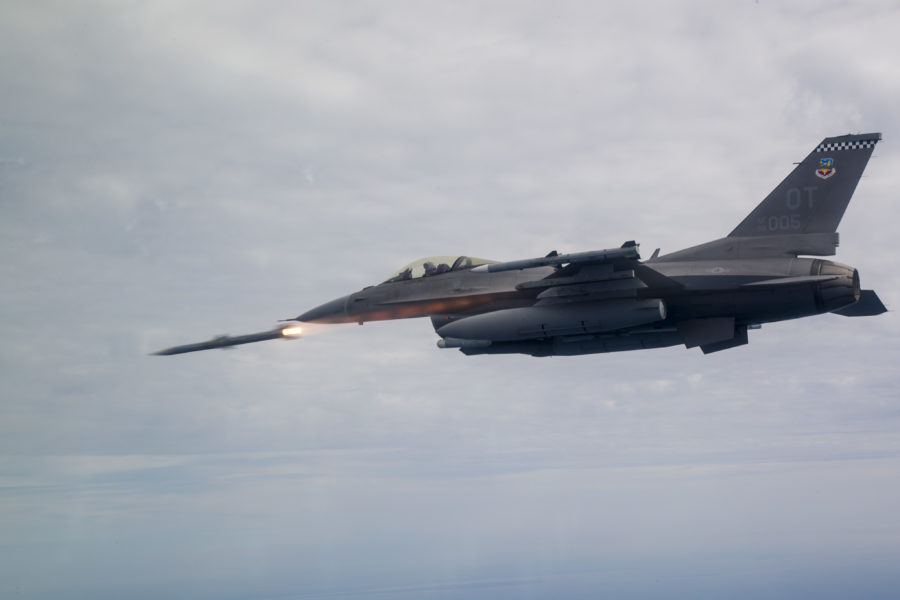The latest version of Raytheon’s AIM-120 Advanced Medium Range Air-to-Air Missile is approaching the “threshold” range required of the new and secretive AIM-260 Joint Advanced Tactical Missile, a company executive said Sept. 10, while suggesting the two weapons may form a high/low mix for future air combat.
John Norman, Raytheon vice president for requirements and capabilities for air and space systems, said the AMRAAM has evolved significantly over its 30-year life. Its range is now “beyond parity” with threat missiles and it will be “complementary” to the AIM-260 JATM built by Lockheed Martin. Norman was speaking on a call with reporters to discuss ways RTX, the parent company of Raytheon, can preserve the credibility of the F-22 now that there is uncertainty about the Next-Generation Air Dominance program.
“The range that we can get with AMRAAM is approaching that threshold capability that the Air Force would like to have with JATM when it’s fielded operationally,” Norman said.
Norman would not discuss specific range performance of the AMRAAM or JATM, but industry sources have suggested the latest versions of AMRAAM can successfully intercept targets at 100 miles, while JATM is intended for targets well beyond 120 miles.
The JATM—built by Lockheed Martin and about which the Air Force has said relatively little—will provide “exquisite capability for the U.S. Air Force warfighters and the Navy warfighters,” Norman said.
JATM will “address the advanced threat, all the countermeasures, the electronic countermeasures that the threats will employ against us. It has exquisite capability against that,” added Norman. Meanwhile, the latest AMRAAM has shown “phenomenal performance” in all those measures during testing with the Air Force.
“Look at AMRAAM as your capacity weapon. … It’s the affordable” weapon, said Norman. JATM, on the other hand, will be the “kick-the-door-down, very expensive weapon.” AMRAAM will be the “capacity weapon, I think, for the foreseeable future,” he said.
Lockheed Martin deferred all inquiries about JATM to the Air Force.
Norman said he believes the the two weapons are “complementary” in the Air Force’s operational assessments of the future.
The latest AMRAAM D3 is the result of collaborative modeling and simulation with the Air Force to address gaps in addressing the threat, Norman said. The service has shared the latest classified threat data with the company and it has recommended ways to close those gaps with weapons either in hand or in development.
Without getting into performance specifics, “what I can tell you is that for what we’re seeing out of the threat analysis today, we have capability with the AMRAAM today with the D3 that counters that threat,” he said.
One improvement is extended range and time of flight. “It’s almost double in the range of what AMRAAM flew before,” Norman claimed.
“We didn’t change propulsion. We just changed the way it flies for long-range shots, so it has more kinetic energy when it hits the target at that range, and it’s able to fly that very effectively. … What that does is, it brings us back into parity [with] a lot of the capability of all the pacing threats worldwide. So it makes AMRAAM kind of ‘future-proof.’”
The missile also has “enhanced capability against all the advanced digital radio frequency modulation [DRFM] jamming techniques that the adversaries employ to try and counter our long-range air weapons, and it’s integrated on significantly more platforms…We’re on 14 different platforms across 43 countries.”
With new cards, the processing time of the D3 is four times faster than the previous iteration, Norman said.
One of the challenges Raytheon faces is getting combat pilots to understand the full capabilities of the new AIM-120, Norman claimed.
“We spend a lot of time out at the Air Force weapons school, with the Air Warfare Center and with the squadrons, with the 85th Test and Evaluation Squadron, the 422 Test and Evaluation Squadron … so that the fighter pilots truly understand, here’s what the missile is capable of, and here’s some different ways that you’re going to employ it in the future,” he said.
The AMRAAM can also be fired from the ground, using the NASAMS (National Advanced Surface-to-Air Missile System), which means countries can employ it as either an air-to-air or air-to-ground weapon.
Many countries are donating older AMRAAMs to Ukraine to use in its NASAMS, Norman said, with some of the missiles dating back 30 years.
“They’re still having an effective rate of over 95 percent. And that’s just wild,” he said.
The future of the missile is just as bright, with increased demand and ramped-up production.
“Historically, we produce anywhere between 450 to 650 AMRAAMs a year across all these lots, and I think you’ve seen over the last few lots, the demand has increased up to 1,200,” Norman said. The company is involved in talks with the Air Force and the State Department about whether the weapon could be produced in another country—Japan is a leading candidate—but Norman said demand would have to reach 2,000 per year to make such a plan feasible.
From an industry perspective, Raytheon and “all of our suppliers, we need to see a consistent demand so that it’s there’s value in that investment. It’s not an easy process to stand up a new production. I think we’re exploring all opportunities,” Norman said.
He said he expected the Lot 38 buy of AMRAAM to be finalized this week.
